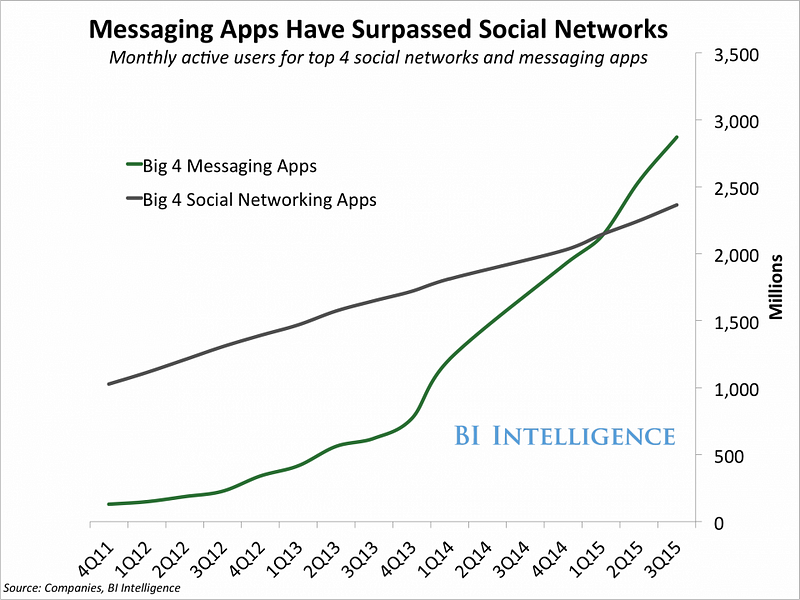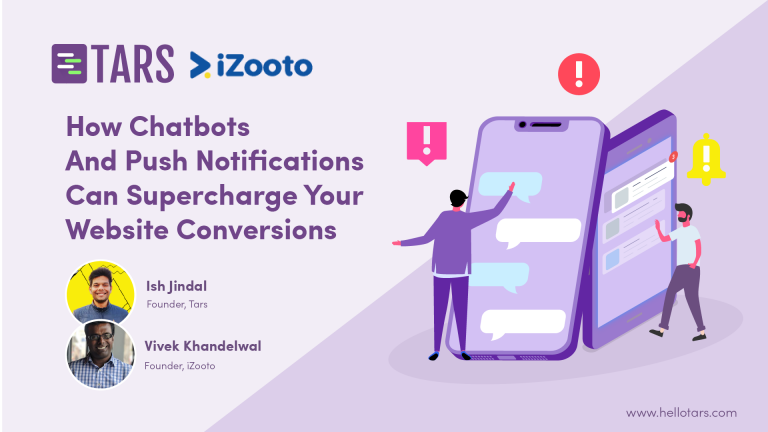A Comprehensive Guide for using Chatbots in your Restaurant

Dominos, TGIF and Pizza Hut all have chatbots and you can too.
Early last year, a high-level Uber executive named Chris Messina claimed that 2016 would be the year of conversational commerce. If you don’t know what that means, then you are normal.
But if you work in the restaurant industry, you should definitely change that.
Silicon Valley has an uncanny habit of creating new tech trends that turn industries on their heads. Conversational commerce is one of those tech trends and the restaurant industry is one of its first targets.
This is your comprehensive guide on why this is the case and how you can get ahead of the curve.
Here’s how this is article is structured. In the sections 1 and 2, I am going to explain what conversational commerce is and why there is growing buzz around it in the tech space. Skip to section 3 if you already know all of this. In section 3, I will discuss what this new tech trend means for the restaurant industry in particular. Finally, section 4 will give you resources you need to get started.
Enjoy!
1. What is conversational commerce?
The term sounds jargony at first, but when you break it down to its fundamental parts, it is fairly basic. Conversational commerce is the process of conducting business by talking to someone. The vast majority of business conducted in human history has been conversational commerce.
If you have ever gone to a corner store, pharmacy or a shopping mall and talked to any of the store attendants you have engaged in conversational commerce.
It can even occur over distances. Ever ordered food through the phone? Or chatted with someone to buy something from them? Those count as conversational commerce as well.
2. Why it matters
There are three reasons you should care about conversational commerce:
Reason 1: The growing popularity of messaging apps.
Think about all the apps you use everyday. A messaging app surely figures near the top of the list.
Unsurprisingly, this is the case for most people with a smartphone. The chart below shows the number of people using the top 4 messaging apps vs the number of people using the top 4 social media apps over time.

In 2015, the top messaging apps overtook the top social network apps in usage by a wide margin.
Implication 1: Your customers are devoting hours of their attention to conversational apps.
Implication 2: Your customers are used to the chat interface because they use it on a daily basis (you will find out why this is important in Section 3).
Reason 2: The proliferation of platforms that allow customer interaction.
The potential of conversational commerce has not gone unnoticed by companies in the space. In the year after Messina’s statement:
- Facebook introduced its Messenger bot platform which allows Facebook pages to create automated chat experiences with users
- Kik, Telegram and Line developed their existing bot platforms further
- Viber opened up public accounts for companies to talk to people
- iMessage added apps within chats.
Seemingly WhatsApp is the only big chat app missing in action (as an Indian this makes me sad), but even they have announced plans for commercial accounts soon. In fact, they are already doing beta testing of commercial accounts with a few businesses now.
Implication: You can now easily interact with your customers in the apps that they use most.
Reason 3: The Increasing capability of Artificial Intelligence.
Conversational commerce has always been hampered by the need for human labour. We get tired, we can only talk to one person at a time, we get stressed out, and most importantly we need to be paid. This makes us too expensive and slow for certain tasks.
Till recently, the solution has been to get customers to serve themselves. Think about travel booking as an example. We have shifted from a model of asking travel agents to bundle flight and hotel bookings for us, to doing it ourselves using the plethora of online hotel and flight booking sites available at our fingertips.
Why? Because we can instantly book flight tickets and hotel rooms on Expedia for cheaper than any travel agent could afford to charge (There is a great piece explaining this shift better and more in-depth that you should check out if you have the time. Here is the link)
Artificial Intelligence (AI) is slowly enabling us to shift back to a paradigm where the user does less on their own. An ideal AI travel assistant would be able to take your travel requirements and book all the flights and hotels you need in one bundle like a travel agent. Unlike a travel agent though, they could do it instantly like an app and for cheaper because there is no human that needs to be paid sitting at the back. Computers cease to be a tool used to do something yourself and more an assistant that is doing things for you.
Before you get too excited we are still a few years away from such a travel assistant. But the underlying AI technology is becoming cheaper, more advanced and readily available. Google, Facebook and IBM all have AI resources available for anyone to use right now.
Implication: Conversational Commerce is becoming cheaper to engage in.
A Quick Note on AI
There are two caveats to consider when thinking about AI. First, AI as it is currently available is still quite raw. A lot of AI out there is still quite stupid:

Second, if you are willing to sacrifice the complexity of the interaction, you do not need AI to create a good and cheap conversational commerce experience.
Check out this example we made to take user feedback for hotel booking:

No AI involved but still feels like you are talking to someone. You’ll find out why conversational commerce is still beneficial without AI in the next section.
3. How can restaurants use this tech?
Restaurants are arguably the pioneers of conversational commerce. One of the only reasons I still use my smartphone to make calls is when I am ordering food. But even this basic use case could stand to be improved significantly by new technology. The primary new channel through which conversational commerce can occur is chatbots.
A chatbot is a piece of software that can respond to a customer’s messages in a chat interface using either AI or pre-programmed rules. The examples we gave above of the AI fail and the hotel booking were both examples of chatbots.
Where can customers find them?
Customers can interact with them in popular messaging apps that support chatbots (FB Messenger, Telegram, Line, Kik) or even on your website.
Here are some examples:
- Web-based bot to replace a landing page (this is the coolest one in my opinion)
- Meme generator bot on Messenger
- Youtube Downloader bot on Telegram
- H&M’s shopping bot on Kik
What can they be used for?
The most obvious use case for such a technology is for food ordering. Users could use a food ordering chatbot much like they would a phone ordering system except instead of talking to a staff member they chat with the bot. Here is an example of a web based Domino’s pizza ordering chatbot:

Another possible use could be a chatbot for taking feedback. Bangalore based food chain Bhukkad uses a conversational feedback form for their delivery orders. You can read more about their experience here or check out the bot that they use over here:

Real-world Examples of Restaurant Chatbots
The three most prominent users of chatbots in the restaurant space are Domino’s, TGI Friday and Pizza Hut. Dominos and Pizzahut use it for food ordering and TGI Friday for making reservations.
What are the advantages of a chatbot?
This is a natural question to ask. All of the examples above could be implemented through an app or a website so why use a bot?
Let’s break it down:
Bots require no extra downloads
Bots have one clear advantage over apps in particular. Customers do not have to download anything extra to use a bot. If you use GrubHub for delivery and a customer has Eat24, the probability that the customer downloads Eat24 just to order from your restaurant is quite low. The average American downloads 1 app per month. In developing market like India, where people have cheaper phones with less memory, the probability becomes lower.
As Cliff Kuang from FastCo Design put it
There’s an enormous amount of friction associated with learning about a new app, downloading it, signing up for it, and then remembering you even have it.
Since users can interact with bots in messaging apps they already have downloaded or in a web browser, the chance of them completing an order goes up.
Chat is mobile optimised
Regular websites don’t fair too much better than apps. While you don’t have to download anything extra to use a website, many websites have a tendency to suck on people’s phones. If they aren’t built correct, they can be slow, clunky and unresponsive. If they aren’t optimised for the phone screen, users can spend ungodly amounts of time pinching and zooming on the screen to figure out what is going on. Even if you do invest enough money to build a good website, the user’s internet connection could give out reducing your beautifully designed site to a continuous stream of loading screens.
Chatbots don’t face these problems. First, chat as an interface was designed with the mobile user in mind. So whether you implement it through an app or your website, the user can easily see what is exactly going on at all times.
Second, if you build a bot within a messaging app like FB Messenger, you can trust Facebook’s highly paid and highly trained UI team to make the interface responsive.
Finally, since each chat interaction happens on a single page the customer never needs to interact with a load screen. To understand this better Compare the domino’s ordering chatbot from before to the domino’s website:
Here’s the bot

Here’s the website:

The fact that I have to use 6 images to depict the regular site and a single image to depict the bot is indicative of the difference between the two.
The chat interface is familiar
Every website and app looks different. Even if you convince a user to use one of them, they have to learn how to navigate their way around. Look at the Domino’s website and bot again. With the website there is so much happening on the screen you do not know where to click.
With the bot on the other hand, the customer knows exactly what to do. The interface is similar to one they use everyday.
Chat feels more human than apps and websites
When a customer interacts with a bot and an app the two experiences feel very different even if they achieve the same thing. Using an app feels like using a tool to achieve something, while using a bot feels like the computer is assisting you through a process.
Before you start building… (Read this whole section. It is very important)
There are two things to consider before you start building your bot. First, I would think long and hard about what function your bot will serve. Remember that AI technologies are still very raw so the tasks a customer gets done through a bot cannot be too complex. Also, in my personal experience of using bots everyday, I have found that the best bots tend to be those which do one or two tasks really well. Add too many tasks and the user can get easily confused because you have to run through far too many menus. I wrote a whole other piece on this that you should check out for a better understanding (Chris Messina recommended it so I promise it is good).
Second, I would try and figure out which platform you want to build your bot on. This will depend largely on where your customers are. Facebook Messenger is fairly universally used so bot developers tend to gravitate towards it. But if you are in a region where another messaging app is popular then build a bot on that platform (Line, Kik, Telegram, etc).
Also consider a bot on your website as an option. Website bots offer two advantages of their app based counterparts. First, in a lot of developing markets, like India, people do not like using Facebook Messenger because it uses too much data and runs very slowly on most phones. In a case like this, you could build a bot on the preferred messaging app in the region or on your website (this is especially true if WhatsApp is the preferred messaging app in your region because WhatsApp does not support bots). Second, Messenger (and Kik and Telegram) bots all face a discovery issue. People do not know how or where to find them. Your website on the other hand is already getting traffic and people can easily run into them on Google. But be warned, if you make a web-based bot it is harder to send users notifications once they have left the site. This could be a downside if you want to ping your customers with discount coupons over time.
How you can get a bot built
You can build a chatbot in two ways. Code it yourself, or use one of the many chatbot building platforms that allow you to do so without code.
Coding it yourself
If you want to make it yourself, here are links to the APIs for some of the more popular chabot platforms:
The bot development community is quite prolific and there are a bunch of Facebook groups where bot makers trade tips and tricks. The biggest group is called Bots (keepin it simple) and you can find it over 👉👉here👈👈.
Additionally, there are A LOT of resources that just straight up give you the code you need to build your first bot for free
Here is a blogpost about building building your first messenger bot.
Here is a github repository where a vibrant community of developers have built an entire Python library for making telegram bots. I have personally used this module and can attest to its usefulness. The examples folder has a few samples bots that can help get the ball rolling.
Using a Bot Builder
If you do not know how to code don’t worry, because the internet has you covered. There are a lot of bot builders that let you create detailed conversational experiences with no coding experience whatsoever.
Here are a few our favourites:

I figured I’d get this one out of the way first because, well… I’m the founder of the company😅.
Over the past 4 (almost 5 years) we have built a zero-code chatbot builder for web-based chatbots. The builder is targeted at marketers so it requires absolutely no coding experience. Each bot is drafted as a flowchart, making it easy for you to design your conversational experience. Using this builder we’ve powered over millions of conversations for over 26,000 bot builders and more importantly, we’ve helped all of them boost user engagement and conversion rate.
In the interest of impartiality though, here is the biggest issue with our product.
We don’t support Messenger chatbots so if you are trying to engage customers on that platform, we aren’t the builder for you.

Manychat is an extremely popular builder for Messenger chatbots used for marketing. They have plethora of guides, videos and most importantly templates to make it easy for you to get started. Manychat treats users as subscribers, which is a good indicator of how they approach the bot-user interaction.
I’ve found that bots created with Manychat function more like powerful content distribution pipelines for a marketing campaign than actual conversations. Think of it like MailChimp, but instead of sending out email, you are sending out messages on FB Messenger. In the context of restaurants, this is a great tool to create an audience of regular customers who you can pepper with some aptly timed coupons.
That being said if you want to have more dynamic two-way conversations with your customers on Messenger look at Chatfuel 👇
Chatfuel

Chatfuel, also focuses solely on Messenger and it also has a bunch of content and templates, but it’s approach to chatbots is more like ours at TARS. Chatfuel drives two-way conversations with your customers.
Where Manychat focuses wholly on Messenger marketing, Chatfuel takes a more comprehensive approach to bots, encouraging business owners to use bots for customer support as well as marketing. The end result is that conversations built on Chatfuel tend to be more complex than the simpler, distribution pipeline approach to Messenger bots that Manychat does. Chatfuel allows for more complex conversations.
This is great if complexity is what you are looking for but cumbersome if you are looking for the simpler content distribution model that Manychat adopts.
Conclusion
Well you have made it to the end! Hopefully you are as amped about conversational commerce as I am now.
If you have any doubts or want some more information, feel free to reach out. You can schedule an email or call with me using this bot. I usually respond pretty quickly.
Further Reading
If you want to read up more on the space I would suggest going to VentureBeat. They have a whole section dedicated to bots that you can find over here.
Medium is also a great platform where bot developers are producing a lot of content. Conveniently enough, you can follow specific topics on medium. Here are the most useful ones for chatbots:
If you found this piece useful, please do share it with others.
Ish is the co-founder at Tars. His day-to-day activities primarily involve making sure that the Tars tech team doesn’t burn the office to the ground. In the process, Ish has become the world champion at using a fire extinguisher and intends to participate in the World Fire Extinguisher championship next year.
- 1. What is conversational commerce?
- 2. Why it matters
- A Quick Note on AI
- 3. How can restaurants use this tech?
- Where can customers find them?
- What can they be used for?
- Real-world Examples of Restaurant Chatbots
- What are the advantages of a chatbot?
- Bots require no extra downloads
- Chat is mobile optimised
- The chat interface is familiar
- Chat feels more human than apps and websites
- How you can get a bot built
- Conclusion
- Further Reading


Build innovative AI Agents that deliver results
Get started for freeRecommended Reading: Check Out Our Favorite Blog Posts!

How We Created A Newsletter That Helps Us Close $50k Deals From Cold Leads

[Webinar] How Chatbots And Push Notifications Can Supercharge Your Website Conversions

Reduce PPC Spend in 2019 While Still Driving Exceptional Results

Our journey in a few numbers
With Tars you can build Conversational AI Agents that truly understand your needs and create intelligent conversations.
years in the conversational AI space
global brands have worked with us
customer conversations automated
countries with deployed AI Agents



